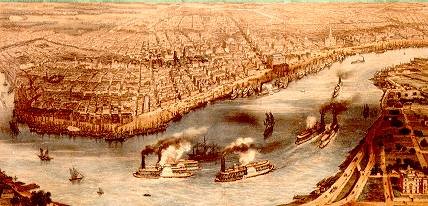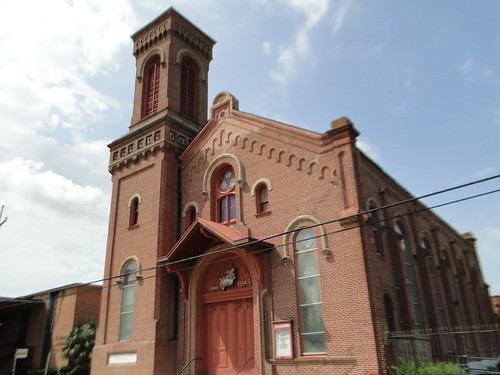Thanks to Janet Schochenmaier (Canada, Alberta), I got to know a very interesting information.
It's about one notice from the Louisiana Marriages to 1850. Original data are coming from: Dodd, Jordan R, et. al.. Early American Marriages: Louisiana to 1850. Bountiful, UT, USA: Precision Indexing Publishers, 19xx.
That source says that on January, 2 1848 Caroline Schockenmeyer and Romuald Jacobs got married in Louisiana (Orleans).
It's pretty amazing as we were sure that there was no Schochenmaiers in the New World before Michael and Jacob had come across the Atlantics in 1886/7.
Of course, we should be careful with that information because we can't prove by means of documents that Caroline belonged to those Schochenmaiers who had settled either in the Russian Empire or in one of the German States.
First of all, it would be good to check her family name's writing for we have already seen some mistakes in transcripting names (on FamilySearch, for example). By doing so, we could control if that "ck" is really "ck" or "ch". The voyels "ey" don't matter at all.
Besides that, it would be interesting to find her in the passagers lists. But, prior to 1850s, it's not so easy to realize. I am not sure that Caroline had come to the USA alone without any relatives. Like that we could state where she had been from and who had come with her.
However, I should point out some historical Details which can help us to admit that information as plausible. Let me remind you the history of Germans in America:
John Law organized the first colonization of Louisiana with German immigrants. Of the over 5,000 Germans initially immigrating primarily from the Alsace Region as few as 500 made up the first wave of immigrants to leave France en route to the Americas. Less than 150 of those first indentured German farmers made it to Louisiana and settled along what became known as the German Coast. With tenacity, determination and the leadership of D'arensburg these Germans felled trees, cleared land, and cultivated the soil with simple hand tools as draft animals were not available. The German coast settlers supplied the budding City of New Orleans with corn, rice, eggs and meat for many years following.
Here you can New Orleans in the middle of 19th century:

Let me quote further:
The largest flow of German immigration to America occurred between 1820 and World War I, during which time nearly six million Germans immigrated to the United States. From 1840 to 1880, they were the largest group of immigrants. Following the Revolutions of 1848 in the German states, a wave of political refugees fled to America, who became known as Forty-Eighters. "Latin farmer" or Latin Settlement is the designation of several settlements founded by some of the Dreissiger and other refugees from Europe after rebellions like the Frankfurter Wachensturm beginning in the 1830s—predominantly in Texas and Missouri, but also in other US states.
German Immigration to United States (1820-2004)
| |||
|---|---|---|---|
Immigration
period |
Number of
Immigrants |
Immigration
period |
Number of
Immigrants |
| 1820–1840 | 160,335 | 1921–1930 | 412,202 |
| 1841–1850 | 434,626 | 1931–1940 | 114,058 |
| 1851–1860 | 951,667 | 1941–1950 | 226,578 |
| 1861–1870 | 787,468 | 1951–1960 | 477,765 |
| 1871–1880 | 718,182 | 1961–1970 | 190,796 |
| 1881–1890 | 1,452,970 | 1971–1980 | 74,414 |
| 1891–1900 | 505,152 | 1981–1990 | 91,961 |
| 1901–1910 | 341,498 | 1991–2000 | 92,606 |
| 1911–1920 | 143,945 | 2001–2004 | 61,253 |
Total : 7,237,594
| |||
Well, if Caroline got married in 1848, she could rich the U.S. between 1720s (first Germans in Louisiana) and 1840s.
It's a huge laps of time.
If she got married in 1848, she could be born before 1820s.
There were about 10 German Churches built prior to 1848:

1. First German Protestant Church and Congregation of New Orleans (1826)
2. German Evangelical-Lutheran St. Paul Congregation (1840)
3. First German Methodist Episcopal Church (1840)
4. German Catholic St. Mary’s Assumption Church Parish in Lafayette (1843)
5. German Evangelical Church and Congregation in Lafayette (1846)
6. German Evangelical St. Matthew Church and Congregation in Carrollton (1847)
7. Craps [Burgundy] Street German Methodist Episcopal Church of the South (1847)
8. German Catholic Church of the Holy Trinity (1847)
9. German Catholic Mater Dolorosa Church in Carrollton (1847)
10. German Evangelical Lutheran Zion Church (1848)
Who knows, maybe, they got married in one of them)))
But the good news is that I found on the FamilySearch the scan of the marriage records:
| Name | Ramualel Jacobs | |||
| Ereignistyp | Marriage | |||
| Ereignisdatum | 02 Jan 1847 | |||
| Ereignisort | Jefferson, Louisiana, United States | |||
| Geschlecht | Male | |||
| Name des Ehepartners | Caroline Schochenmayer | |||
| Geschlecht des Ehepartners | Female | |||
Now you can find out that her Name was Caroline SCHOCHENMAYER and they got married in the Parish of Jefferson, City of Lafayette (now it's part of New Orleans, Faubourg Lafayette).
Here it is:

Let's have a closer look at the scans:

By the way, what about Mr. Romuald Jacobs or Jacobi? Is the any information about him?
Some persons could be suitable
| Name | Romuald Heinrich Jacobi | |||
Geschlecht
|
Male
29 September 1818
| |||
| Geburtsort | DUESSELDORF STADT,RHEINLAND,PRUSSIA | |||
| Name des Vaters | Georg Arnold Jacobi | |||
| Name der Mutter | Luise Brinckmann | |||
Well, in 1848, he was about 30 years old...
In the 1840 U.S. Federal Census you may also find a R. Jacob, who was living precisely in Jefferson:
| Name: | R Jacob |
|---|---|
| Home in 1840 (City, County, State): | Jefferson, Louisiana |
| Free White Persons - Males - Under 5: | 1 |
| Free White Persons - Males - 20 thru 29: | 2 |
| Free White Persons - Females - Under 5: | 1 |
| Free White Persons - Females - 20 thru 29: | 1 |
| Free White Persons - Under 20: | 2 |
| Free White Persons - 20 thru 49: | 3 |
| Total Free White Persons: | 5 |
| Total All Persons - Free White, Free Colored, Slaves: | 5 |
From the churches listed above only two are to be found in Lafayette. If our ancestors had been Protestants than there were married in :
| Today's Jackson Avenue Evangelical Congregation was formed in September 1845. Their first church, constructed in 1846, was located at the corner of Philip and Chippewa Streets.
The original church and parish hallof the German Evangelical Church and Congregation in Lafayette.
|  |
Now it looks like that:

If our ancestors had been Catholics, than they could visit
German Catholic St. Mary’s Assumption Church Parish in Lafayette (1843)

History

Prior to the expansion of New Orleans before the Civil War, today's Garden District and Irish Channel comprised a separate city which was known as Lafayette. In the 1840's a flood of immigrants from Germany and Ireland, many of whom were Catholic, came into this French-speaking area. When a German-speaking Redemptorist priest, Fr. Peter Czackert, came through New Orleans in 1842, Bishop Antoine Blanc, seeing this as a heaven-sent way of providing spiritual care for members of his growing German flock, asked him to minister to them.
 In 1847 this young Catholic Parish was officially turned over to the Redemptorists, with Fr. Czackert as pastor. Though he died the next year, he was accompanied by, and followed by, other Redemptorist priests and brothers of remarkable vision, energy and faith. They found themselves ministering to three national language groups: the French, the Irish and the German. And within ten years the Redemptorists had built three separate permanent church buildings: St. Mary's Assumption (German), replacing the frame church, St. Alphonsus (Irish), and Notre Dame de Bon Secours (French).
In 1847 this young Catholic Parish was officially turned over to the Redemptorists, with Fr. Czackert as pastor. Though he died the next year, he was accompanied by, and followed by, other Redemptorist priests and brothers of remarkable vision, energy and faith. They found themselves ministering to three national language groups: the French, the Irish and the German. And within ten years the Redemptorists had built three separate permanent church buildings: St. Mary's Assumption (German), replacing the frame church, St. Alphonsus (Irish), and Notre Dame de Bon Secours (French).It's still there:

So, we may conclude that there was at least one Person with the Family Name Schochenmayer in the U.S. prior to 1880s. We have no idea when and how Caroline had come to the New World, but I think it's a good path to follow. I was said that all refugees from Germany had Chosen between the West (US) and East (Russia). The Germans from Palatinate, Baden and Swabia orginized several "trains" in 1820s towards South Russia and South United States in order to be successful. Who knows, maybe one part of our relatives had preffered the U.S., while another one fled to the Russian Empire.
I hope we'll find our more about that mysterious Caroline)))


